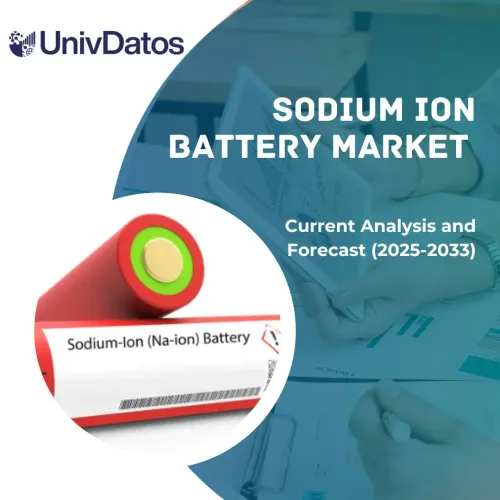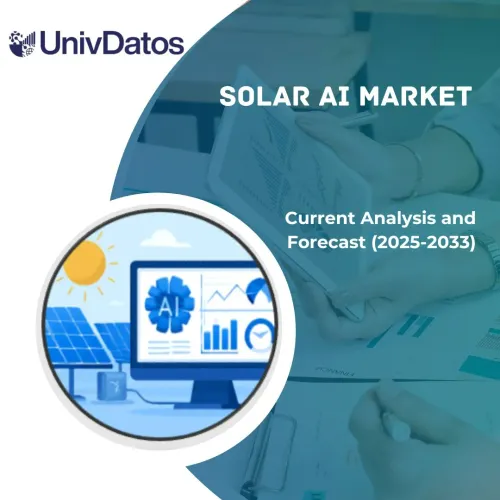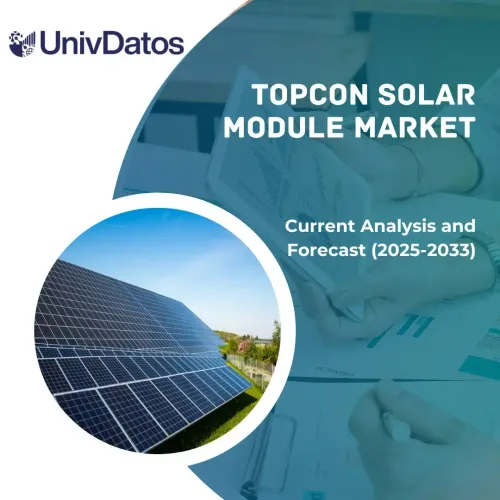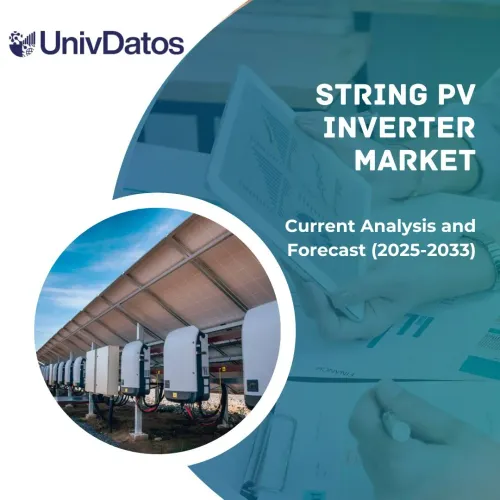- Home
- About Us
- Industry
- Services
- Reading
- Contact Us
Onshore Wind Power Market: Current Analysis and Forecast (2022-2030)
Emphasis on Capacity (Below 500 KW, 500 KW – 2 MW, and Above 2 MW); wind capacity (High, Medium, and Low); Grid Connectivity (Off-Grid and On-Grid); End-User (Residential and Commercial); and Region/Country
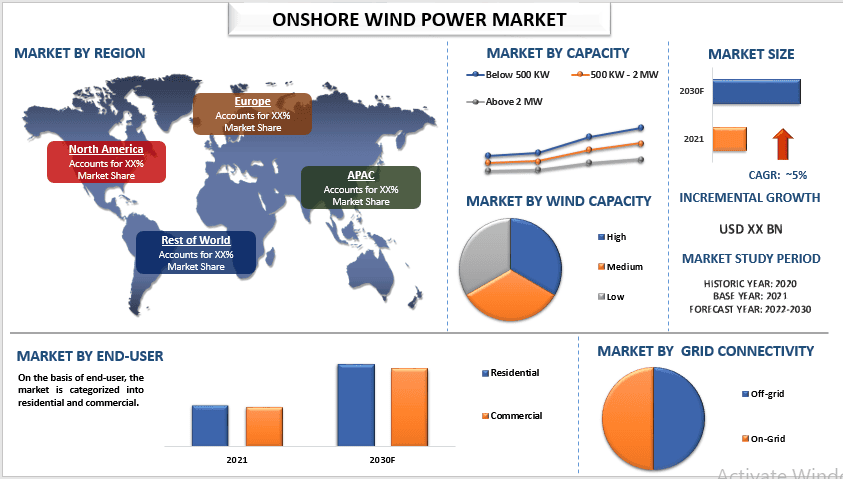
Global Onshore Wind Power Market was valued at USD 40 billion in 2021 and is expected to grow at a CAGR of 5% from 2022-2030. Onshore Wind Power is defined as the power that’s generated by wind turbines located on land driven by the natural movement of the air. These wind farms are majorly located in fields or more rural areas or less populated areas. The industry involved the development, installation, operation, and maintenance of wind turbines located on land. Including the supply chain of various equipment such as turbines, towers, blades, generators, and other related components including various services such as project management, site assessments, and maintenance. Thus, increasing the market value of onshore wind power across the world. For instance, In Jun 2022, GE acquired a 49% stake in Continuum Green Energy (India) and led a 148.5-megawatt (MW) Morjar onshore wind project in Gujarat to provide power to local communities of 125,000 households in India.
Siemens Gamesa Renewable Energy, S.A.; Suzlon Energy Limited; Vestas; NORDEX SE; Mingyang Smart Energy; GENERAL ELECTRIC; Goldwind; ENVISION GROUP; Zhejiang Windey Co., Ltd.; SANY Group are some of the key players in the market. Several M&As along with partnerships have been undertaken by these players to facilitate customers with hi-tech and innovative products/technologies.
Insights Presented in the Report
“Amongst capacity, the above 2 MW category is expected to grow with a significant CAGR during the forecast period”
Based on capacity, the market is segmented into Below 500 KW, 500 KW – 2 MW, and Above 2 MW. The above 2 MW category is expected to grow with a significant CAGR during the forecast period. This is mainly owing to the factor that 2 MW capacity has better wind turbine technology and efficiency, reducing the cost of energy for sites with low and medium wind speeds. Many players are launching projects with high MW to help in generating more power used for household purposes. For instance, in Jan 2023, Mingyang launched an 8.5 MW onshore wind turbine to generate 200,000 kWh daily.
“Amongst grid connectivity, on-grid categories are expected to grow with a significant CAGR during the forecast period”
Based on grid connectivity, the onshore wind power market has been classified into off-grid and on-grid. The on-grid categories are expected to grow with a significant CAGR during the forecast period. This is mainly owing to the reason that onshore wind power is considered one of the most mature and cost-friendly forms of renewable energy and it has been growing significantly across the globe. In addition, it is expected to grow over time as increasing the number of projects is growing along with the global transitions of renewable energy acceleration.
“Europe is anticipated to grow at a substantial CAGR during the forecast period”
In 2021, Europe is anticipated to grow at a substantial CAGR during the forecast period. This is mainly owing to the factor has Europe is becoming the global leader in renewable energy. Also, Wind power has played an important part to bring this success and will be key to achieving the EU’s renewable energy targets and make the EU carbon neutral by 2050. In addition, in 2022, Germany, Sweden, and Finland built the most onshore wind farms in Europe, 87% of the new wind installations done in Europe last year were onshore wind. Furthermore, according to Eurostat, wind accounted for over one-third (37%) of the total electricity generated from renewable sources in the EU in 2021. Moreover, many major companies are collaborating with other firms to increase their business portfolio. For instance, in Jul 2022, Ørsted acquired the German and French onshore wind platform Ostwind for USD 761.16 million.
Onshore Wind Power Market Report Coverage

Reasons to buy this report:
- The study includes market sizing and forecasting analysis validated by authenticated key industry experts.
- The report presents a quick review of overall industry performance at one glance.
- The report covers an in-depth analysis of prominent industry peers with a primary focus on key business financials, product portfolios, expansion strategies, and recent developments.
- Detailed examination of drivers, restraints, key trends, and opportunities prevailing in the industry.
- The study comprehensively covers the market across different segments.
- Deep dive regional level analysis of the industry.
Customization Options:
The global onshore wind power market can further be customized as per the requirement or any other market segment. Besides this, UMI understands that you may have your own business needs, hence feel free to connect with us to get a report that completely suits your requirements.
Table of Content
Research Methodology for the Onshore Wind Power Market Analysis (2022-2030)
Analyzing the historical market, estimating the current market, and forecasting the future market of the global onshore wind power market were the three major steps undertaken to create and analyze the adoption of onshore wind power in major regions globally. Exhaustive secondary research was conducted to collect the historical market numbers and estimate the current market size. Secondly, to validate these insights, numerous findings and assumptions were taken into consideration. Moreover, exhaustive primary interviews were also conducted, with industry experts across the value chain of the global onshore wind power market. Post assumption and validation of market numbers through primary interviews, we employed a top-down/bottom-up approach to forecasting the complete market size. Thereafter, market breakdown and data triangulation methods were adopted to estimate and analyze the market size of segments and sub-segments of the industry pertains to. Detailed methodology is explained below:
Analysis of Historical Market Size
Step 1: In-Depth Study of Secondary Sources:
Detail secondary study was conducted to obtain the historical market size of the onshore wind power market through company internal sources such as annual reports & financial statements, performance presentations, press releases, etc., and external sources including journals, news & articles, government publications, competitor publications, sector reports, third-party database, and other credible publications.
Step 2: Market Segmentation:
After obtaining the historical market size of the onshore wind power market, we conducted a detailed secondary analysis to gather historical market insights and share for different segments & sub-segments for major regions. Major segments are included in the report as capacity, wind capacity, grid connectivity, end-user. Further country-level analyses were conducted to evaluate the overall adoption of testing models in that region.
Step 3: Factor Analysis:
After acquiring the historical market size of different segments and sub-segments, we conducted a detailed factor analysis to estimate the current market size of the onshore wind power market. Further, we conducted factor analysis using dependent and independent variables such as various capacity, wind capacity, grid connectivity, end-users of onshore wind power. A thorough analysis was conducted for demand and supply-side scenarios considering top partnerships, mergers and acquisitions, business expansion, and product launches in the onshore wind power market sector across the globe.
Current Market Size Estimate & Forecast
Current Market Sizing: Based on actionable insights from the above 3 steps, we arrived at the current market size, key players in the global onshore wind power market, and market shares of the segments. All the required percentage shares split, and market breakdowns were determined using the above-mentioned secondary approach and were verified through primary interviews.
Estimation & Forecasting: For market estimation and forecast, weights were assigned to different factors including drivers & trends, restraints, and opportunities available for the stakeholders. After analyzing these factors, relevant forecasting techniques i.e., the top-down/bottom-up approach were applied to arrive at the market forecast for 2028 for different segments and sub-segments across the major markets globally. The research methodology adopted to estimate the market size encompasses:
- The industry’s market size, in terms of revenue (USD) and the adoption rate of the onshore wind power market across the major markets domestically
- All percentage shares, splits, and breakdowns of market segments and sub-segments
- Key players in the global onshore wind power market in terms of products offered. Also, the growth strategies adopted by these players to compete in the fast-growing market
Market Size and Share Validation
Primary Research: In-depth interviews were conducted with the Key Opinion Leaders (KOLs) including Top Level Executives (CXO/VPs, Sales Head, Marketing Head, Operational Head, Regional Head, Country Head, etc.) across major regions. Primary research findings were then summarized, and statistical analysis was performed to prove the stated hypothesis. Inputs from primary research were consolidated with secondary findings, hence turning information into actionable insights.
Split of Primary Participants in Different Regions

Market Engineering
The data triangulation technique was employed to complete the overall market estimation and to arrive at precise statistical numbers for each segment and sub-segment of the global onshore wind power market. Data was split into several segments & sub-segments post studying various parameters and trends in the areas of capacity, wind capacity, grid connectivity, end-user in the global onshore wind power market.
The main objective of the Global Onshore Wind Power Market Study
The current & future market trends of the global Onshore Wind Power market were pinpointed in the study. Investors can gain strategic insights to base their discretion for investments on the qualitative and quantitative analysis performed in the study. Current and future market trends determined the overall attractiveness of the market at a regional level, providing a platform for the industrial participant to exploit the untapped market to benefit from a first-mover advantage. Other quantitative goals of the studies include:
- Analyze the current and forecast market size of the onshore wind power market in terms of value (USD). Also, analyze the current and forecast market size of different segments and sub-segments
- Segments in the study include areas of capacity, wind capacity, grid connectivity, and end-user.
- Define and analysis of the regulatory framework for the onshore wind power
- Analyze the value chain involved with the presence of various intermediaries, along with analyzing customer and competitor behaviors of the industry.
- Analyze the current and forecast market size of the onshore wind power market for the major region.
- Major countries of regions studied in the report include Asia Pacific, Europe, North America, and the Rest of the World.
- Company profiles of the onshore wind power market and the growth strategies adopted by the market players to sustain in the fast-growing market
- Deep dive regional level analysis of the industry
Related Reports
Customers who bought this item also bought


